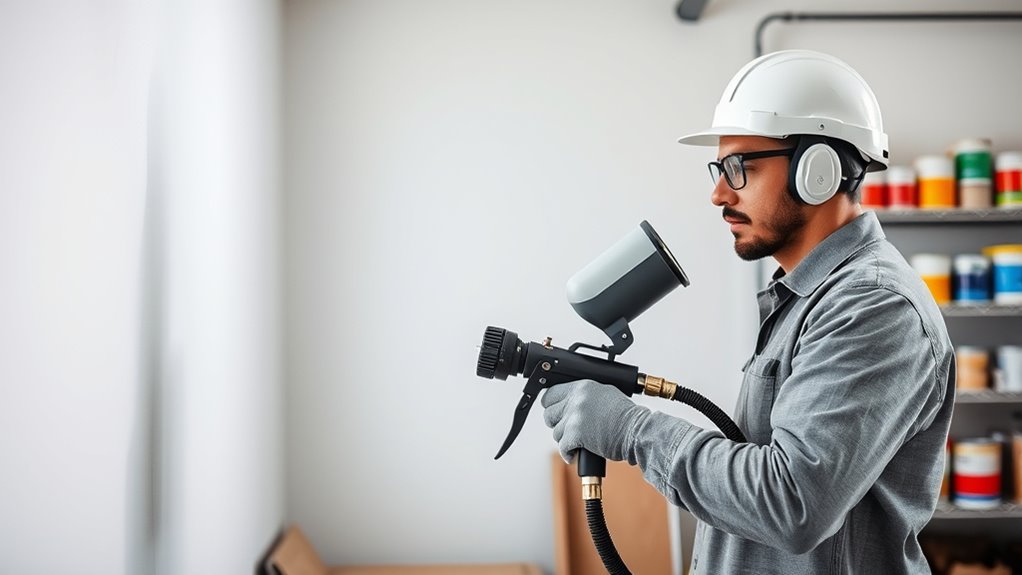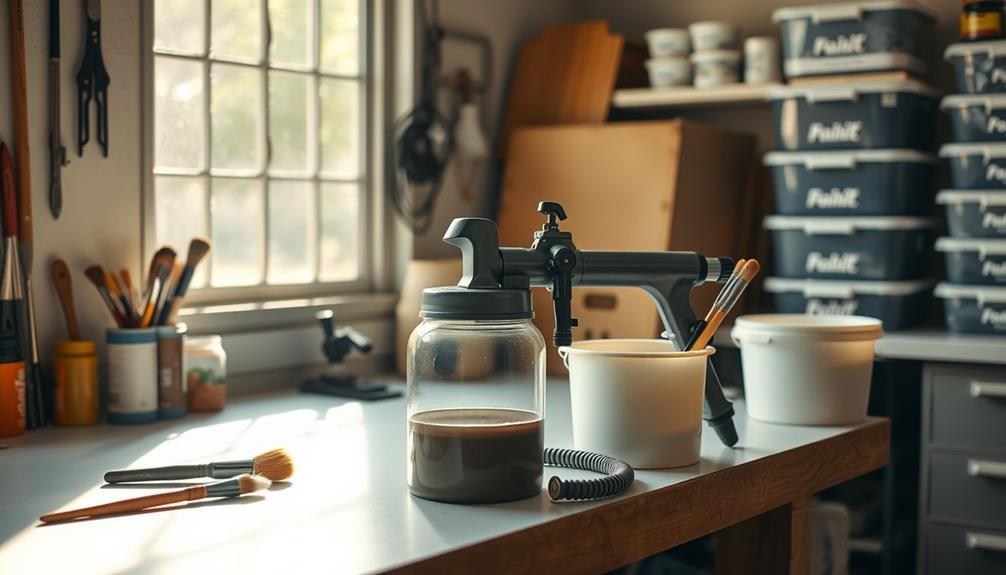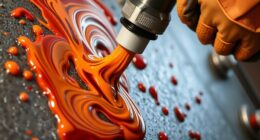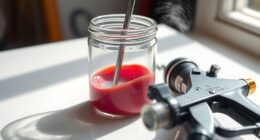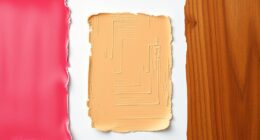Many myths about airless sprayers dampen your enthusiasm, but they’re easier to use and cleaner than you think. You might believe they’re complicated or waste too much paint, but modern models with adjustable settings help control flow and overspray. They aren’t just for pros and are perfect for DIY projects at home. Cleaning and maintenance are straightforward, making these tools more accessible than misconceptions suggest. Keep exploring to uncover the truths behind these powerful painting machines.
Key Takeaways
- Airless sprayers are simple to operate and become easier with practice, debunking the myth of their complexity.
- Proper technique and modern features help control overspray, reducing paint waste significantly.
- They are suitable for DIYers and homeowners, not just professionals or large projects.
- Cleaning is straightforward with standard flushing methods, making maintenance quick and manageable.
- Designed for minimal mess and easy upkeep, airless sprayers are user-friendly and promote consistent results.
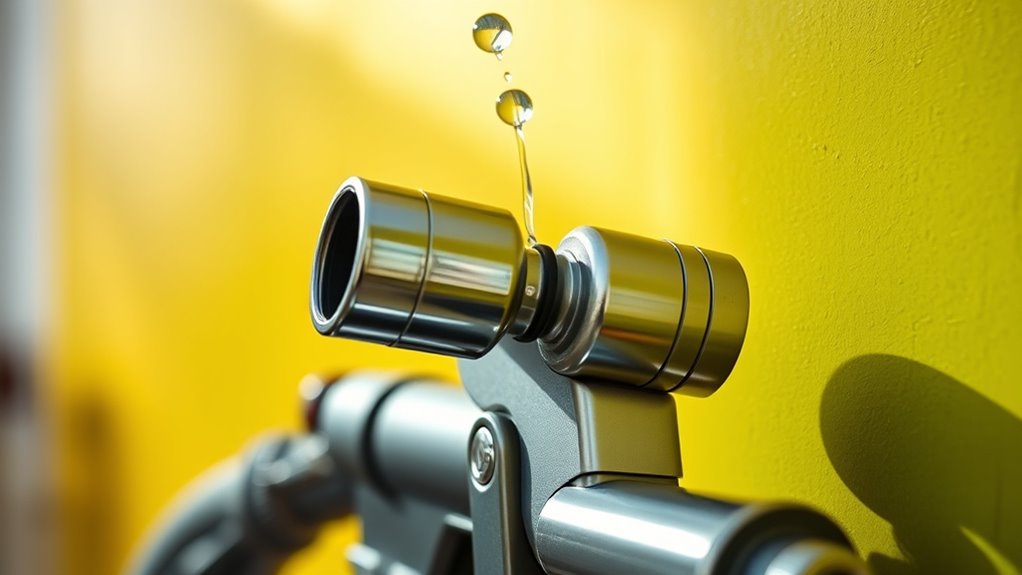
Many myths about airless sprayers persist, causing confusion and sometimes discouraging their use. You might hear that they’re too complicated to operate or that they create a mess that’s impossible to clean up. But the truth is, once you understand how they work, you’ll see that airless sprayers are straightforward tools that can save you time and effort. They’re designed for efficiency, providing a smooth, even finish on your projects, whether you’re painting a room or applying a protective coating outdoors. The misconception that they’re difficult to learn often keeps people from trying them out, but with a little practice, you’ll find operating an airless sprayer becomes second nature.
Airless sprayers are simple, efficient tools that save time and effort on your projects.
Another common myth is that airless sprayers waste a lot of material. You might think that because the spray pattern is powerful, you’re losing a lot of paint to overspray. While overspray can happen if you’re not careful, modern airless sprayers come with adjustable pressure settings and tips that help you control the flow precisely. When used correctly, they minimize waste, making your projects more economical. It’s also worth noting that airless sprayers tend to produce less overspray than traditional spray guns, especially when you take the time to set up and practice on a scrap surface first. You’ll find that with proper technique, you can use less paint while achieving a superior finish.
Some believe that airless sprayers are only suitable for professionals or large-scale projects. This isn’t true at all. While professionals do use these tools for their speed and efficiency, homeowners and DIY enthusiasts benefit just as much from their capabilities. Smaller, more affordable models are available that fit your needs, whether you’re updating a single wall or tackling an entire house. You don’t need to be an expert to get started—just follow the manufacturer’s instructions, and you’ll be surprised how easily you can produce professional-looking results. Plus, with the right safety precautions, such as wearing masks and protective gear, you can operate these sprayers safely regardless of your experience level.
Lastly, many think that cleaning an airless sprayer is a hassle. While cleaning is necessary, it’s not as intimidating as you might imagine. Most models have straightforward cleaning protocols: you flush the system with water or solvent after use, depending on the material. Regular maintenance keeps your sprayer functioning well and extends its lifespan. Spending a few minutes on cleanup after each use ensures you’re ready for the next project without frustration. In reality, the convenience of faster application and better coverage outweighs any minor effort required for cleaning, making airless sprayers an efficient addition to your toolkit. Additionally, proper maintenance can help prevent clogs and prolong the life of your equipment, further simplifying your painting tasks.
Frequently Asked Questions
Can Airless Sprayers Be Used for Interior Painting Projects?
Yes, you can use airless sprayers for interior painting projects. They provide a fast, even finish and are especially useful for large surfaces like walls and ceilings. Just make sure to prep the area properly, cover furniture, and use the right pressure settings to avoid overspray. With a bit of practice, you’ll find that airless sprayers make interior painting quicker and more efficient, giving you professional-looking results.
Are Airless Sprayers Suitable for All Types of Paint?
Airless sprayers work well with most types of paint, but you should verify the manufacturer’s recommendations first. They handle thick paints like latex and primers easily, providing a smooth, even finish. However, some specialty paints, such as oil-based or very thin coatings, might require adjustments or different equipment. Always test small amounts beforehand to ensure compatibility and achieve the best results for your project.
How Long Does It Take to Clean an Airless Sprayer?
It typically takes about 15 to 30 minutes to clean an airless sprayer thoroughly. You’ll want to flush out the paint with water or solvent, depending on the paint type, and clean the nozzle and filters. To save time, follow the manufacturer’s cleaning instructions carefully. Regular maintenance guarantees your sprayer stays in good condition and works efficiently for future projects, making cleaning a quick and manageable task.
Do Airless Sprayers Require Special Safety Gear?
Sure, you need special safety gear—because splattering paint and fumes are just fashion statements, right? Actually, yes. You should wear gloves, goggles, and a respirator to protect yourself from high-pressure paint and potentially harmful fumes. Skipping safety gear isn’t just reckless; it could land you in the ER. So, gear up like a pro, because staying safe is way more stylish than a paint splash on your clothes.
Can Airless Sprayers Be Used Outdoors in Rainy Weather?
You shouldn’t use an airless sprayer outdoors in rainy weather. Rain and high humidity can affect the quality of your paint job, causing uneven coverage or drips. Plus, water exposure can damage the equipment or cause safety hazards. It’s best to wait for dry, clear weather to guarantee ideal results and keep your sprayer functioning properly. Always check the manufacturer’s recommendations before use in specific weather conditions.
Conclusion
Now that you’ve seen through these myths, it’s clear that airless sprayers are more versatile and reliable than many believe. Maybe, just maybe, the paint can wait a little longer, and you’ll discover how much easier your projects become when you trust the facts over old stories. After all, sometimes the biggest surprises come from the truths we’ve overlooked. So, give an airless sprayer a shot—you might find it’s exactly what you needed all along.
